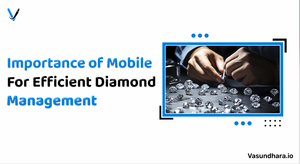More from Vasundhara Infotech
More in Politics
Related Blogs
Archives
Social Share
Body
Did you know that by 2023, mobile apps are expected to produce more than $935 billion in revenue?
With an estimated 5.25 billion smartphone users globally, it's no surprise that businesses are turning to mobile apps as a valuable tool for connecting with their customers.
But it's not just about the money; mobile apps provide numerous advantages to businesses of all sizes.
In recent years, the diamond business, which is known for its luxury and perfection, has undergone a dramatic metamorphosis.
As the diamond business welcomes technological breakthroughs, a rising awareness of the need to upgrade management processes has emerged.
The transition from old approaches to technology-driven solutions is critical for long-term viability and efficiency.
This article examines the issues that traditional diamond management procedures face, as well as the use of mobile apps in addressing these obstacles.
Challenges in Traditional Diamond Management
With its complex supply chain and high stakes, the diamond business has always faced difficulties stemming from outdated management techniques and are in need of diamond industry app solutions in a changing landscape.
These issues have grown more pressing in light of shifting global dynamics, emphasizing the necessity for creative solutions to guarantee the sector's sustained prosperity.
Complexities in Supply Chain Logistics
The diamond supply chain, which involves several steps from extraction to retail, is well known for its complexity.
The complexity of global supply chain logistics is too much for traditional management, which causes mistakes, delays, and inefficiencies.
Inefficiencies in Inventory Tracking and Management
Ensuring precise inventory tracking is fundamental to the efficient administration of diamonds.
Traditional approaches to manual monitoring and record-keeping frequently give rise to inconsistencies, thereby posing a difficulty in attaining up-to-date visibility into the inventory.
Communication Bottlenecks Among Stakeholders
Difficulties in communication that arise among various stakeholders—miners, manufacturers, merchants, and retailers—obstruct the seamless progression of business activities.
Conventional modes of communication frequently exhibit inefficiency and susceptibility to misinterpretations, thereby impeding the efficacy of decision-making procedures.
The Rise of Mobile Apps in Diamond Management
Mobile apps have emerged as transformative tools, reshaping traditional practices in the diamond industry.
Mobile Apps as Catalysts for Change
The incorporation of mobile applications signifies a fundamental change in the management approach of the diamond industry.
Mobile applications serve as catalysts for transformation through the provision of inventive resolutions to enduring obstacles, promoting effectiveness, openness, and cooperation.
Mobile applications transcend geographical limitations, granting stakeholders immediate and location-independent access to vital information.
The enhanced level of accessibility promotes smooth cooperation among various parties involved, including retailers and miners, thereby cultivating a supply chain that is more interconnected and adaptable.
Streamlining Inventory Management
Mobile applications make use of RFID and GPS technology to offer unparalleled real-time monitoring and tracking capabilities for diamonds.
This practice guarantees accuracy in their whereabouts across the supply chain, thereby mitigating the potential for larceny and facilitating punctual deliveries.
Abolish the need for manual revisions. Mobile applications streamline the inventory updating procedure, ensuring that records are current and accurate.
By implementing this method, errors that are typically associated with manual data entry are reduced and time is saved.
Improving Communication and Collaboration
Through the use of mobile apps, stakeholders can communicate seamlessly and get over communication barriers that are often present in traditional management techniques.
Real-time communication between miners, manufacturers, traders, and retailers promotes cooperation and guarantees that all parties are informed.
Mobile apps' immediate messaging capabilities are essential for resolving communication problems.
In the complex world of diamond management, the emergence of mobile apps represents a fundamental shift toward efficiency, transparency, and interconnection rather than merely a technological advancement.
Case Studies: Success Stories with Mobile Apps
Within the ever-evolving field of diamond management, mobile applications have come to the fore and transformed the ways in which well-known diamond enterprises operate.
Let's examine how mobile apps have helped prominent figures in the sector, highlighting the precise efficiency gains that have been noted as well as the practical effects on their day-to-day operations.
DeBeers Group: DeBeers, an international authority in diamonds, adopted mobile applications to improve supply chain visibility.
Their app enables stakeholders to monitor the real-time location of diamonds, ensuring efficiency and transparency from mining to retail.
As an outcome, the supply chain is optimized and the decision-making procedures are enhanced.
Results:
Mobile applications enabled efficient and smooth communication among stakeholders for organizations such as DeBeers.
Constant communication and updates ensured that retailers, manufacturers, and miners were well-informed, which facilitated enhanced collaboration and quicker decision-making.
Tiffany & Co.: Tiffany & Co., a renowned luxury jewelry brand, utilized mobile applications to enhance the consumer experience.
By incorporating augmented reality into their application, clients are able to virtually examine diamond pieces.
This innovative methodology has played a role in the augmentation of consumer involvement and revenue.
Results
The mobile application developed by Tiffany & Co. revolutionized the consumer experience.
Real-time product information and virtual try-on capabilities increased customer satisfaction, thereby strengthening the brand's relationship with its clientele and positively influencing sales.
The aforementioned case studies illustrate how renowned diamond corporations have effectively utilized mobile applications to improve not only operational effectiveness but also the overall satisfaction of their clientele.
Future Trends in Diamond Management Apps
Emerging trends in mobile application technology are positioned to bring about unprecedented advancements in the field of diamond management.
Artificial Intelligence (AI) and blockchain technology are poised to have a transformative impact on the tracking, trading, and management of diamonds.
With the assistance of AI-powered predictive analytics, businesses will be able to forecast market trends, optimize inventories, and formulate well-informed strategic choices.
Blockchain technology guarantees secure and transparent transactions by maintaining an immutable ledger of a diamond's progression from its mine to the market.
This effectively resolves apprehensions pertaining to integrity and moral sourcing.
Furthermore, the incorporation of augmented reality (AR) will facilitate virtual examinations, thereby revolutionizing the assessment and exchange of diamonds.
Beyond technological advancements, the future of diamond management applications involves the development of an industry that is more resilient, transparent, and technologically advanced.
Considerations for Choosing the Right Mobile App
Choosing the right mobile app for a diamond company involves careful consideration of various factors to ensure that the app meets the specific needs of the business and its users.
Here are some key considerations:
Purpose and Goals
Clearly state the mobile application's goal. Is it for sales, customer interaction, inventory management, or a mix of these?
Establish the objectives you hope to accomplish with the app, such as boosting sales, increasing productivity, improving customer satisfaction, or simplifying communication.
Platform
Based on your target market and market share, choose whether to design the app for iOS, Android, or both platforms.
If you want to have a presence on both platforms with the least amount of development work, think about utilizing cross-platform development tools.
User Experience (UX) and User Interface (UI)
Give top priority to creating a user-friendly design that meets the unique requirements of the diamond sector.
To improve user experience, make sure the app's UI is clear, eye-catching, and compliant with industry standards.
Security
Give security features a priority to safeguard client data, trade secrets, and data integrity because the diamond sector is highly sensitive.
Use encryption techniques and secure authentication procedures to protect private data.
Integration
Ensure that the application integrates without difficulty with the diamond company's existing systems, databases, and enterprise software.
E-commerce platforms, CRM, and ERP, among others, can be integrated with e-commerce platforms to increase overall business efficiency.
Maintenance and Cost
Plan for regular updates and maintenance to address bug fixes, security vulnerabilities, and compatibility issues with new operating system versions.
Evaluate the total cost of ownership, including development, maintenance, and potential licensing fees. Consider the return on investment (ROI) in relation to the app's benefits.
Conclusion
The use of mobile apps in diamond management has had a transformational effect on the industry.
As we see the success stories and developments made possible by mobile apps, it becomes increasingly important to promote widespread usage of this technology within the diamond business.
The benefits extend beyond individual businesses, adding to the sector's overall growth and sustainability.
As the diamond industry embraces the full potential of mobile app solutions, the future promises tremendous possibilities.
Are you ready to revolutionize your diamond management practices with Vasundhara Infotech?
Contact us, your trusted partner in app development, to explore tailor-made solutions that will propel your business into the future of diamond management. Request for quotes for FREE!















Comments